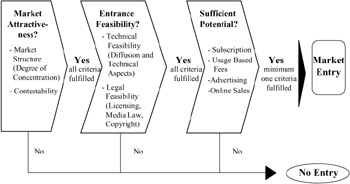Research Framework and Data Collection
To analyze the options for entering traditional TV markets via Internet-based TV, and to examine the industry and the broader environment faced by Internet-based TV market entrants, we have developed a sequential framework using the following three key questions (see also Loebbecke & Falkenberg, 2002a, b):
-
Is the respective TV market attractive for new entrants?
-
Is an Internet-based market entrance feasible considering technical (transmission, diffusion) and legal (media law, copyright) issues?
-
What revenue sources might be tapped?
The framework is termed 'sequential' because at every stage an immediate exit is suggested if the result of the analysis is not satisfactory (see Figure 1).

Figure 1: Checkpoints for the Feasibility of Internet-Based TV— A Sequential Framework (Loebbecke & Falkenberg, 2002a, p. 96)
Additionally, a market survey based on secondary data was conducted to judge the attractiveness of the German TV market. Using secondary data for industry-wide datagathering seems appropriate (Emory, 1976). Furthermore, the collection of primary data would have been impractical and inefficient. The main source of information was the German Commission on Concentration in the Media - KEK (2001). We also analyzed data provided by the leading publication for media information in Germany, Media Perspektiven, published monthly by the Arbeitsgemeinschaft der ARD-Werbegesellschaften. Specific additional data was collected from other sources and is referenced individually.
Before testing the framework by applying it to the German TV market, characteristics of TV markets in general and specific data on the German market are presented in the following section.
EAN: 2147483647
Pages: 198